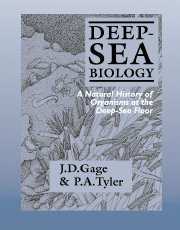Book contents
- Frontmatter
- Contents
- Preface
- Acknowledgements
- PART I The development of deep-sea biology, the physical environment and methods of study
- PART II Organisms of the deep-sea benthic boundary
- PART III Patterns in space
- PART IV Processes: patterns in time
- 11 Food resources, energetics and feeding strategies
- 12 Metabolic processes: microbial ecology, and organism and community respiration at the deep-sea bed
- 13 Reproduction, recruitment and growth of deep-sea organisms
- 14 Animal–sediment relations in the deep sea
- PART V Parallel systems and anthropogenic effects
- References
- Species index
- Subject index
13 - Reproduction, recruitment and growth of deep-sea organisms
Published online by Cambridge University Press: 05 June 2012
- Frontmatter
- Contents
- Preface
- Acknowledgements
- PART I The development of deep-sea biology, the physical environment and methods of study
- PART II Organisms of the deep-sea benthic boundary
- PART III Patterns in space
- PART IV Processes: patterns in time
- 11 Food resources, energetics and feeding strategies
- 12 Metabolic processes: microbial ecology, and organism and community respiration at the deep-sea bed
- 13 Reproduction, recruitment and growth of deep-sea organisms
- 14 Animal–sediment relations in the deep sea
- PART V Parallel systems and anthropogenic effects
- References
- Species index
- Subject index
Summary
ASSUMPTIONS AND PREDICTIONS
Until recently, some of the least understood biological processes in the deep ocean have been those associated with the mode of reproduction, growth and survivorship of deep-sea organisms and the demography of their populations. Early observations of sexuality, gonad development and brooding were made as brief comments in the major taxonomic works whilst information on recruitment and growth was non-existent. The sampling programmes of the early deep-sea expeditions aimed at wide spatial coverage to give descriptive information rather than long-term sampling designs at fixed stations. Hence reproductive development could not be followed through its various stages from initiation to maturity – as is routinely done in shallow-water and intertidal species (Giese & Pearse, 1974), nor could the recruitment and subsequent growth of discrete cohorts be assessed. Our knowledge of these processes in deep-sea invertebrates and fish still remains scanty.
On the basis of the constant temperature regime of the deep ocean, Orton (1920) predicted that deep-sea species would not undergo the seasonal periodicities in breeding shown by their relatives in shallower water subject to annual changes in water temperature, but, instead, breeding would take place year-round.
Another prediction concerned the mode of early development of deep-sea organisms. In shallow water most marine invertebrates produce vast numbers of tiny eggs that hatch into characteristic planktonic larvae which feed in water and are dispersed by water currents. These eventually settle on to the bottom metamorphosing from the planktonic form to a juvenile form of the adult.
- Type
- Chapter
- Information
- Deep-Sea BiologyA Natural History of Organisms at the Deep-Sea Floor, pp. 301 - 336Publisher: Cambridge University PressPrint publication year: 1991
Accessibility information
- 1
- Cited by

